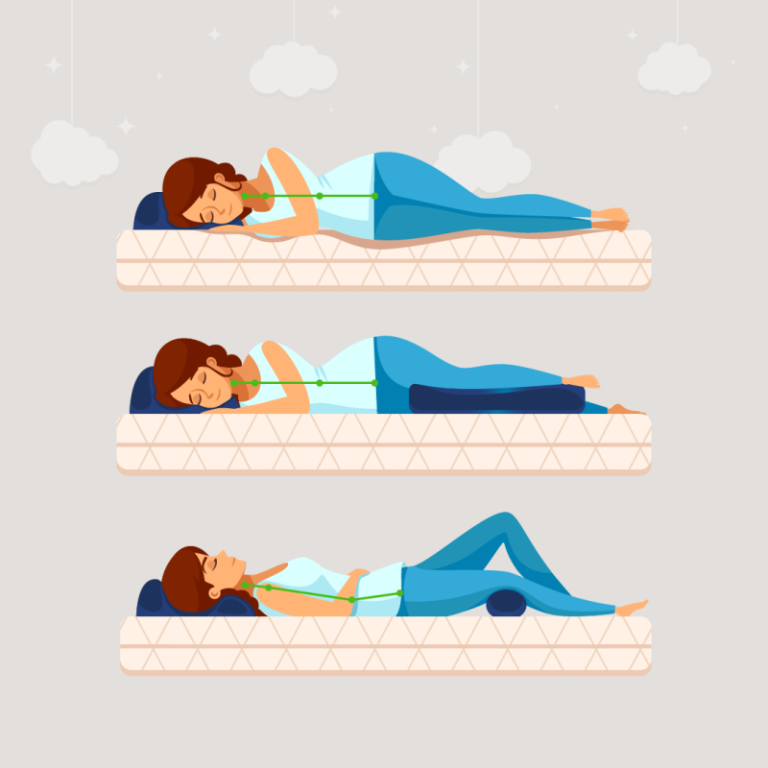
Each of us has our preferred sleeping position. Even if some parts of your night routine, like your bedtime schedule, change from time to time, chances are the sleep position that you got accustomed to will remain consistent. In fact, a study revealed that most people switch positions between 10 to 40 times each night, but we tend to go back to our “default” sleep position.
Sleeping Position and Sleep Quality
Multiple studies revealed the correlation between the body’s sleep posture and sleep quality. Our body works to restore and repair itself during sleep, and your position can either aid or hinder that process.
The way we sleep is a matter of preference. However, just because we feel comfortable doesn’t necessarily mean that it is good for our sleep health as well as our general health. If you’re noticing new body pains and worsened health conditions when you wake up – your sleeping position might be the culprit. Poor sleep caused by poor posture can lead to issues such as:
- Trouble concentrating or forgetfulness
- Moodiness
- Fatigue
- Headaches
- Chronic back pain or generalized body pain
- Impaired circulation
- Sleep apnea
- Digestive issues
Healthy Sleep Positions
You are not required to switch up your sleep position especially if it causes you even more stress – it is hard to break a habit after all. But if taking the time to slowly get used to a new posture could solve your chronic health issues or improve your sleep quality, it might be worth trying it. Now, let’s dive into the most common sleeping positions and their pros & cons.
#1 Sleeping on Your Side
Also known as the ‘lateral sleeping position’, side sleeping is the most popular position by far. A study showed that more than 60% of people, mostly men, spend more time dozing on their side.
Side sleepers generally sleep on either the left or the right side of their body. They could also be stretched out in a “log” form or curled up in a “fetal” position. This type of sleeper also often uses a pillow to hug or tuck in between their shoulders and head.
This sleeping posture can alleviate pressure on the spine which may help prevent neck and lower back pain. It also promotes better airflow for people suffering from sleep-related breathing issues. Moreover, there’s also enough research that suggests sleeping on your left side as a more effective way to aid digestion.
Who Will Benefit from Side Sleeping?
- Pregnant women – experts generally recommend lying on your side with your knees bent during pregnancy. This position relieves the pressure of your baby’s weight, enabling the heart to pump blood easily.
- People with Acid Reflux – studies show that sleeping on your left side makes GERD or acid reflux symptoms less frequent and less severe.
- People with lower back pain – sleep on your side while keeping your knees bent to help balance the body and minimise pressure on the lumbar spine.
- People who snore or with sleep apnea – maintaining a side position can help the airways stay open during sleep, reducing snoring and easing mild apnea.
Downsides of Side Sleeping
- Shoulder stiffness
- Jaw tightness on the side you’re sleeping on
- Cuts off the circulation in the arm you’re sleeping on
Choosing a Mattress for Side Sleepers
For optimised comfort, people who sleep on their side should go for a mattress with a soft to medium firmness level to keep your spine aligned and avoid shoulder pain.
#2 Sleeping on Your Back
The second most popular sleeping position is sleeping on your back, also referred to as the ‘supine position’ by sleep experts. Back sleepers lay flat on their back with their arms on their side, which kind of resembles a soldier’s standing posture.
What makes this sleeping posture one of the healthiest is that you stay in a neutral position, reducing the pressure on your head, neck and spine.
Who Will Benefit from Back Sleeping?
- People with lumbar spinal pain – sleeping on your back keeps your body and spine evenly aligned, thus, lessening the strain on your pressure points.
- People who want to avoid getting wrinkles – consistent contact with the pillow may cause stress to the skin and contribute to wrinkles.
- People with neck pain – dozing on your back controls spine misalignment that can occur in other sleep positions.
- People with congested nose – if you often suffer from nasal congestion caused by allergies at night, keeping a supine position with your upper back propped up using pillows, allows your airways to stay open and may help drain your nose.
Downsides of Back Sleeping
- Increases snoring and worsen sleep apnea
- Pain in the lower back
- Worsens GERD and acid reflux symptoms
Choosing a Mattress for Back Sleepers
For proper back alignment, back sleepers would want to opt for a mattress with medium firmness that relieves pressure on the lower back while raising the hips to align with the shoulders
#3 Sleeping on Your Stomach
Research indicates that people spend less than 10% of their bedtime sleeping on their stomachs, making it the least popular among the most common sleeping positions. Lying on your stomach or “free fall sleeping” provides the least support and puts on more pressure on your spine, resulting in body aches. Furthermore, sleeping in this position requires you to sleep with your neck twisted to one side, causing misalignment in the head and spine.
Who Will Benefit From Free Fall Sleeping?
People who snore or with sleep apnea – experts suggest that this position reduces obstruction of the airway, which helps relieve sleep apnea symptoms and minimise snoring.
Downsides of Free Fall Sleeping
- Increased neck and lower back pain
- Straining at the joints, especially the shoulders
- General sense of body soreness
Choosing a Mattress for Free Fall Sleepers
Ideally, you should avoid sleeping on your stomach. But if this is really how you prefer to sleep, you can make this position healthier by investing in a firm or ultra-firm mattress to prevent your pressure points from sinking in.
What is the Best Sleeping Position?
In general, the healthiest sleeping position is sleeping on your side since it provides the most benefits to our health and overall comfort – despite this, the reality is this position would not work for everyone. Thus, the best sleeping position is still where your spine is properly aligned, and your pressure points are well-supported.
Elevate your sleep quality by selecting a mattress that properly supports your sleeping position. Find out which mattress is right for you!





